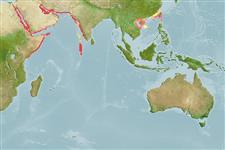Preferred temperature (Ref.
123201): 24.5 - 29.2, mean 27 °C (based on 236 cells).
Phylogenetic diversity index (Ref.
82804): PD
50 = 0.5000 [Uniqueness, from 0.5 = low to 2.0 = high].
Bayesian length-weight: a=0.02344 (0.01103 - 0.04981), b=2.96 (2.79 - 3.13), in cm total length, based on LWR estimates for this Genus-body shape (Ref.
93245).
Trophic level (Ref.
69278): 2.0 ±0.00 se; based on food items.
Widerstandsfähigkeit (Ref.
120179): mittel, Verdopplung der Population dauert 1,4 - 4,4 Jahre. (Preliminary K or Fecundity.).
Fishing Vulnerability (Ref.
59153): Low to moderate vulnerability (30 of 100).
Climate Vulnerability (Ref.
125649): Very high vulnerability (86 of 100).
Nutrients (Ref.
124155): Calcium = 50.8 [21.1, 141.8] mg/100g; Iron = 0.699 [0.269, 1.686] mg/100g; Protein = 18.2 [16.8, 19.4] %; Omega3 = 0.1 [0.0, 0.2] g/100g; Selenium = 20 [7, 57] μg/100g; VitaminA = 37.3 [8.5, 152.4] μg/100g; Zinc = 2.64 [0.84, 4.83] mg/100g (wet weight);
